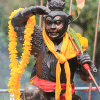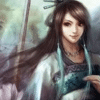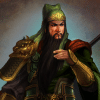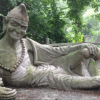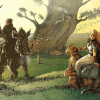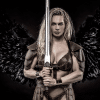
Norse
Ymir: The First Living Thing in Norse Mythology
Ymir: The First Living Thing in Norse Mythology
Ymir was a giant who emerged at the beginning of time. Keep reading to learn how the frost giant’s body was used to make the world we live in!
According to Norse legends, the first living thing in all of creation was a giant.
This was Ymir, who was formed from the mists that swirled in a vast empty void known as Ginnungagap. He became the ancestor of the giants.
When the gods were created, however, conflict arose. The tyrannical Ymir was killed by Odin and his two brothers.
The giant lived on, however, in our own world. In a shocking story that is surprisingly typical of ancient cultures, Ymir’s body was broken up to create the world of men.
The Creation of Ymir
According to the Norse creation myth, an empty space called Ginnungagap was all that existed in the beginning.
Sources are unclear as to whether Yggdrasil, the great World Tree, even existed. Most, however, seem to imply that Yggdrasil was eternal and Ginnungagap lay along its length in the space that would later be occupied by the Nine Worlds.
In the north was a well that gave water to Yggdrasil. The tree did not drink all of it, however, and small amounts of water began to spill out of the well.
The northern part of Ginnungagap was extremely cold. The water that was not taken in by Yggdrasil quickly froze.
At first this was only a small amount of ice. Eventually, however, there was enough to form the frozen world of Niflheim.
The southern regions of Ginunngagap grew hotter and hotter in the meantime. This area became Muspelheim, the land of fire.
The slight bit of warmth that reached Niflheim from the south made small droplets of water thaw and drip off of the icy world’s underside. A fire fell as far as Muspelheim, where they created sparks, but the rising heat made most evaporate before then.
The steam and mists that this created began to fill Ginunngagap. They grew thicker until they took shape.
From this concentrated mist, Ymir was born. He was the first jötunn.
The jötnar are often called giants in modern translations, but their characters and physicalities differed. Some were similar to gods, others were troll-like, and some were connected to primordial elements.
Ymir was the first of the primordial giants. He was as cold as the ice that had formed him.
The mists also created an enormous cow called Auðumla. She sustained herself on the salty ice that hung off Niflheim while Ymir grew large and strong by drinking her milk.
The Births of the Gods and Giants
In time, both Ymir and Auðumla created new life in Ginnungagap.
Ymir was a frosty being who was made of elemental ice. When the heat of Muspelheim reached him, he began to drip with sweat.
These droplets each took a human-like shape as they fell off of his body. These became new jötnar, who are generally considered to all be frost giants.
Meanwhile, Auðumla was creating a different race from the ice of Niflheim.
As she continually licked one patch of ice, it began to take shape. Eventually, it formed Búri, the first god.
Auðumla nourished the god she had created in the same way she had Ymir. Like the giant, he did not need to grow to adulthood because he had been created as a fully-grown figure, but the cow’s milk made him stronger.
Búri eventually had at least one child, although the existence of the mother is never confirmed. He may have created Borr from his own body, mated with one of the giantesses, or had a sister born from the ice in the same way he had been.
According to some versions of the legend, Búri also had a daughter named Bestla whose mother was likely a giantess. Borr married his sister, then faded from the record.
Borr and Bestla had three sons who they named Odin, Vili, and Vé. The brothers were strong and noble, but were without a home and greatly outnumbered by Ymir’s children.
The Death of Ymir
Most sources seem to imply that Ymir and his offspring were cruel, even evil.
The conflicts between the giants and the new race of gods are never made clear in written records, but most modern retellings imply that Ymir was abusive and tyrannical, particularly to the three young gods who were not descended from him.
A conversation from the Prose Edda clarified that peace was not possible between the first gods and the early giants.
“Was there,” asked Gangler, “any kind of equality or any degree of good understanding between these two races?”
“Far from it,” replied Har; “for the sons of Bor slew the giant Ymir, and when he fell there ran so much blood from his wounds, that the whole race of Frost-giants was drowned in it, except a single giant, who saved himself with his household. He is called by the giants Bergelmir. He escaped by going on board his bark, and with him went his wife, and from them are descended the Frost-giants.”
-Snorri Sturluson, Prose Edda, Gylfaginning (trans Blackwell)
Borr’s sons, Odin, Vili, and Vé, killed the giant who had oppressed them in Ginnungagap. The deluge of blood was so powerful that most of Ymir’s wicked children were drowned.
Death, however, was not the end of Ymir’s story. The brothers embraced the act of creation while they cleared the giant’s body out of Ginnungagap.
The Body Put to Use
Odin and his brothers decided to put Ymir’s body to good use. It was so massive that it needed to be moved before anything else could be created in Ginnungagap, so they decided to remake it into a new world.
Every part of Ymir’s body was used in creating the new world. Surviving sources paint a vivid picture of what went into the process.
- Ymir’s flesh became the land.
- His bones and teeth were used to make mountains, cliffs, and fjords.
- His blood was collected to create water, including the sea, lakes, and rivers.
- Ymir’s skull was placed over the new world to become the dome of the sky.
- His brains were thrown into the newly-made sky to be clouds.
- In some accounts, Ymir’s eyes were plucked out. One became the sun while the other was the moon.
- His hair and beard became the trees and grasses that covered the land.
The brothers had created the first non-elemental world from Ymir’s remains. They were pleased with their efforts, but they knew they weren’t done.
The sun and moon provided some light, but the sky still looked empty. They caught sparks that flew out of Muspelheim and trapped them in the dome as stars.
The few giants who had survived Ymir’s destruction would, they knew, pose a threat to this new world in the future. To protect it, they used Ymir’s eyelashes to construct a palisade around the central landmass.
They named this new world Midgard, or the Middle Enclosure. Many modern English texts translate this as Middle Earth.
It was named for its place along the center of Yggdrasil’s length, but also for the protective wall that enclosed it. Just as future towns and farms would be protected from outside threats by walls, Midgard was protected from the jötnar.
Odin and his brothers opted not to live on Midgard themselves, however. Instead, they decided to create an entirely new race to inhabit the first world.
They plucked twigs from Yggdrasil and carved them into two shapes, male and female. They gave these creations life as Ask and Embla, the first man and woman.
The creation myth does not go on to detail how the other worlds were made or how the gods increased their numbers. After Ymir’s body was used to create Midgard, the most important aspect of the story for human writers was complete.
Parallels to Ymir
Many readers are amazed at the gore and brutality suggested by the Norse creation myth. In Ymir and the way his body was used, however, historians see themes that are common in many religions.
In the 10th century BC, the Rig Veda described the formation of the world according to early Hindu tradition. A cosmic being called Purusha, the text claims, was dissected in an act of creation.
This story, predating the written Scandinavian records by nearly two thousand years, is similar even in what body parts were used. Purusha’s eye became the sun, for example, and his head becomes the heavens, or the sky.
In Ireland, it is the body of a bull instead of a giant that becomes the land. Other details are consistent, however, and historians have pointed out the inclusion of a giant bovine in born the Norse and Irish traditions.
In a culture that was contemporary with the Viking Age but geographically far removed, a 9th century Zorastrian text describes the world being formed from the skin and bones of a malevolent spirit.
The motif is so prevalent that many scholars consider it to be a central aspect of Indo-European mythologies. They believe that cultures that lost the story are the outliers while creation from a body is the norm.
Even cultures that appear to have once abandoned the tradition sometimes reclaimed it later. Ovid, for example, wrote that the body of Atlas was used in that way although earlier Greco-Roman myths make no similar claims.
The mythology of Greece and Rome does, however, include another motif that seems to be in play in Ymir’s legend. Both Greco-Roman and Norse mythologies include elements of violent succession.
The central theme of the Greek creation myth is the violent revolt of younger gods against the previous generation. Both Cronus and Zeus rebelled against their fathers to seize kingship.
While Odin, Vili, and Vé were not the children of Ymir, the Norse story is still in keeping with this theme. The tyrannical primordial deity was overthrown by younger gods who, in both cases, were three brothers.
These stories also use this act of rebellion as the beginnings of later conflicts. Ymir’s offspring would become the Aesir gods’ enemies while the defeat of Cronus prompted an attack by Greece’s own giants.
The Norse creation myth seems particularly brutal, but it is actually an example of several common motifs. Proto-Indo-European religion, it would seem, was founded on a tale of violent, bloody succession.
The Frost Giants
Odin and his brothers defeated Ymir, but that was not the end of the threat he posed. Although most of his children were killed in the aftermath of his death, Ymir’s jötnar offspring would become eternal enemies of the Aesir.
The earliest jötnar described in stories of creation are usually thought to all be frost giants. Later texts make largely no distinction between the varieties of jötnar, however, so it is unclear whether they were the ancestors of all giants or only one race.
Some of the jötnar, in fact, were not enemies of the gods. Giantesses sometimes married into the pantheon and some of the valkyries were said to be jötnar.
None of these are particularly associated with an element in the way the frost giants are. Skaði, for example, makes her home in the mountains but is not described in the same terms as Ymir and his children.
Elemental giants do not appear again until Ragnarök, the end of the world.
In most accounts, however, frost giants are not the primary threat of Ragnarök. Instead, it is the previously unmentioned fire giants of Muspelheim that invade Midgard and Asgard.
Some stories do say that frost giants emerge from Niflheim, but just as often the ice world brings forth the dead rather than a living race.
Several theories exist that could explain the different types of jötnar described in Norse myths.
Some believe that all jötnar were, in fact, descended from Ymir. Over time they diverged into different groups, just as humans formed different cultures, but all retained the same lineage.
Others believe that the jötnar of most stories are a completely different species than the frost and fire giants. Norse mythology has similar issues differentiating between types of elves or dwarves, so it is not unreasonable to think that the word jötnar was applied broadly.
The other option is that the giants of Jötunheim developed from an entirely different tradition than their elemental kin. The groups came from different traditions but once they were incorporated into Norse culture were mistakenly grouped under the same name.
The Legacy of Ymir
According to Norse legends, creation began in an empty void known as Ginnungagap. Eventually, mist and vapor coalesced to form the bodies of a giant and a cow.
The giant was named Ymir. His sweat formed a race of frost giants that shared his malevolence.
The cow, meanwhile, had created another new race. The first gods were formed by her and their descendants were Odin and his brothers.
The brothers killed Ymir. The blood that poured out of his body flowed so fast that it washed away most of the frost giants that he had created.
Odin and his brothers used every part of Ymir’s body to make a new world. This became Midgard, the world of men.
The use of Ymir’s body seems grotesque, but it is actually in keeping with established traditions in Indo-European cultures. The Norse were one of many societies that believed their world had been made from the flesh and bones of a primal being.
